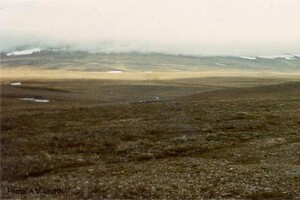As temperatures rise, forests will occupy the northern territories.

Siberian tundra may disappear completely by 2500 global warming. To prevent this, it is necessary to reduce greenhouse gas emissions, which accelerate climate change, according to Live Science.
Even in the most optimistic scenario, two-thirds of the local landscape with a short growing season and cover, consisting mainly of grasses, mosses, shrubs and lichens will disappear, leaving behind two fragments separated by 2,500 kilometers. Melting permafrost of the tundra will release the greenhouse gases contained in it, which will further accelerate global warming.
Read also: Russia suffers from global warming and its attack on Ukraine looks like a convulsion of a dying state them. Helmholtz of the Alfred Wegener Institute Stefan Kruse. The disappearance of the tundra will not only damage biodiversity and human culture, but may also increase warming in the Arctic, which is already twice as fast as in other parts of the world.
Between 1960 and 2019, temperatures in the Arctic region rose by an average of four degrees Celsius. This has reduced sea ice and affected the Arctic landmass. One of the consequences of rising temperatures is the movement of forests to the north.
How quickly such forests will be able to replace the grassy-shrub ecosystem of the tundra is unknown. According to Kruse, the change in the forest line in response to global warming varies around the world. In some regions the trees moved north, in others they remained in place. Previous studies of the tundra have been conducted in small areas, but circumstances may vary from site to site.
Now Kruse and his colleague Ulrike Herzsu have created a new computer model that has estimated the entire space of the Siberian tundra 4,000 kilometers long. This model takes into account the life cycle of individual trees: from how far it can sow seeds, to how well it grows when faced with competition from other trees. In addition, the growth rate is taken into account depending on the temperature, precipitation and depth of summer thawing of permafrost.
It turns out that when trees begin to move north in response to global warming, they do so quickly. Moreover, they are unlikely to retreat if the temperature drops again. In a scenario where carbon emissions are reduced to zero by 2100 and temperatures rise to within two degrees Celsius, only 32.7% of today's tundra will remain by 2500. And it will be divided into two mini-tundra: one in Chukotka, one on the Taimyr Peninsula.
But even this scenario can be unattainable if important actions are not taken very quickly. This means that the outcome of climate change for the tundra can be much worse. In the average scenario, in which carbon emissions will not be reduced by 2050 and halved by 2100, only 5.7% of the current tundra area will remain uncovered by 2500.
In a scenario with faster warming, the trees could move 30 kilometers to the north. When scientists simulated the cooling of the climate that followed the warming, they found that the trees would not recede as quickly as they approached. Cruze emphasizes that once mature trees take root, they can withstand a lot.
Researchers have not directly modeled how the reduction in tundra area will affect its inhabitants, such as reindeer. But living in two populations separated by a space that interferes with intergroup crossing usually has a negative effect on the species. Reindeer migrate from north to south and back during the year, it is unknown how the spread of the forest will affect these migrations.
The consequences will be felt by humans. Indigenous peoples, such as the Nenets, graze and hunt reindeer. According to Kruse, the loss of the tundra could affect the culture of these peoples.
How the disappearance of the tundra will affect the future of global warming is also unclear. But covering mossy, bushy meadows with trees can aggravate the situation. The snow-covered tundra is lighter than the canopy of deciduous forests. That is, the forest will absorb more heat, which can make the Arctic an even hotter place. And this extra heat can increase the melting of the permafrost of the tundra, which contains a huge amount of greenhouse gases. Melting will lead to their release, as well as “wake up” bacteria and viruses.
The changes are not likely to be limited to replacing the tundra with deciduous forests. As more and more permafrost melts during the hotter summers, evergreen trees will migrate. They remain covered with leaves all year round, absorbing even more heat than deciduous trees. The southern side of the taiga, where temperatures are already higher than the north, is likely to heat up even more, leading to droughts and forest fires that emit even more carbon.
Formerly the World Meteorological Organization (WMO) ) stated that there is a chance that the average temperature on the planet will reach 1.5 degrees above pre-industrial levels in the next five years . These chances are estimated at about 50/50.
See the special topic: The snow-capped Alps are turning green, and the changes are already visible from space This is due to global warming. Eating insects can help cope with climate change: how it is possible Scientists call insects an important source of protein. Davos 2022: “Green Transition” and digitalization will define the labor market of the future At the same time, “traditional spheres” of the economy remain equally important. WMO has made a disappointing forecast for global warming The chances that temperatures on the planet will be 1.5 degrees above pre-industrial levels have increased. South Asia – record heat: there may be more problems than COVID-19 Many people in Asia are now suffering from heat stroke.




